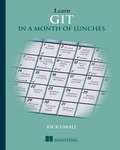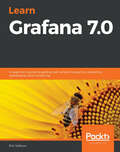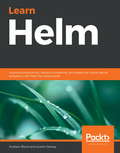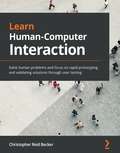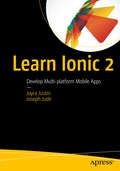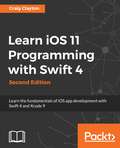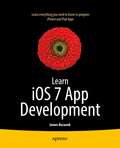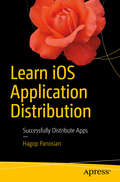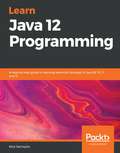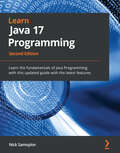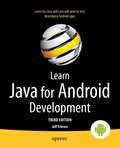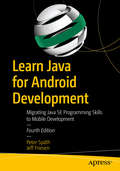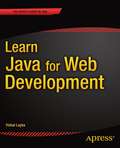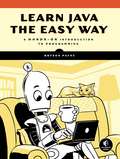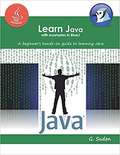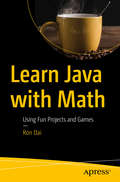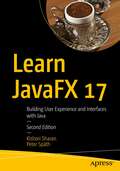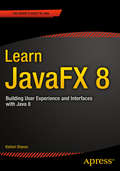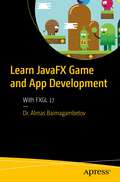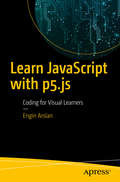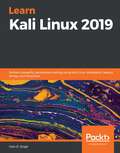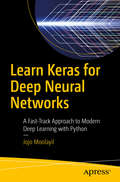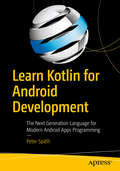- Table View
- List View
Learn Git in a Month of Lunches
by Rick UmaliSummaryLearn Git in a Month of Lunches introduces the discipline of source code control using Git. Whether you're a newbie or a busy pro moving your source control to Git, you'll appreciate how this book concentrates on the components of Git you'll use every day. In easy-to-follow lessons designed to take an hour or less, you'll dig into Git's distributed collaboration model, along with core concepts like committing, branching, and merging.Purchase of the print book includes a free eBook in PDF, Kindle, and ePub formats from Manning Publications.About the BookGit is the source code control system preferred by modern development teams. Its decentralized architecture and lightning-fast branching let you concentrate on your code instead of tedious version control tasks. At first, Git may seem like a sprawling beast. Fortunately, to get started you just need to master a few essential techniques. Read on!Learn Git in a Month of Lunches introduces the discipline of source code control using Git. Helpful for both newbies who have never used source control and busy pros, this book concentrates on the components of Git you'll use every day. In easy-to-follow lessons that take an hour or less, you'll dig into Git's distributed collaboration model, along with core concepts like committing, branching, and merging. This book is a road map to the commands and processes you need to be instantly productive.What's InsideStart from square one—no experience requiredThe most frequently used Git commandsMental models that show how Git worksLearn when and how to branch codeAbout the ReaderNo previous experience with Git or other source control systems is required.About the AuthorRick Umali uses Git daily as a developer and is a skilled consultant, trainer, and speaker.Table of ContentsBefore you beginAn overview of Git and version controlGetting oriented with GitMaking and using a Git repositoryUsing Git with a GUITracking and updating files in GitCommitting parts of changesThe time machine that is GitTaking a fork in the roadMerging branchesCloningCollaborating with remotesPushing your changesKeeping in syncSoftware archaeologyUnderstanding git rebaseWorkflows and branching conventionsWorking with GitHubThird-party tools and GitSharpening your Git
Learn Grafana 7.0: A beginner's guide to getting well versed in analytics, interactive dashboards, and monitoring
by Eric SalituroA comprehensive introduction to help you get up and running with creating interactive dashboards to visualize and monitor time-series data in no time Key Features Install, set up, and configure Grafana for real-time data analysis and visualization Visualize and monitor data using data sources such as InfluxDB, Prometheus, and Elasticsearch Explore Grafana's multi-cloud support with Microsoft Azure, Amazon CloudWatch, and Google Stackdriver Book Description Grafana is an open-source analytical platform used to analyze and monitoring time-series data. This beginner's guide will help you get to grips with Grafana's new features for querying, visualizing, and exploring metrics and logs no matter where they are stored. The book begins by showing you how to install and set up the Grafana server. You'll explore the working mechanism of various components of the Grafana interface along with its security features, and learn how to visualize and monitor data using, InfluxDB, Prometheus, Logstash, and Elasticsearch. This Grafana book covers the advanced features of the Graph panel and shows you how Stat, Table, Bar Gauge, and Text are used. You'll build dynamic dashboards to perform end-to-end analytics and label and organize dashboards into folders to make them easier to find. As you progress, the book delves into the administrative aspects of Grafana by creating alerts, setting permissions for teams, and implementing user authentication. Along with exploring Grafana's multi-cloud monitoring support, you'll also learn about Grafana Loki, which is a backend logger for users running Prometheus and Kubernetes. By the end of this book, you'll have gained all the knowledge you need to start building interactive dashboards. What you will learn Find out how to visualize data using Grafana Understand how to work with the major components of the Graph panel Explore mixed data sources, query inspector, and time interval settings Discover advanced dashboard features such as annotations, templating with variables, dashboard linking, and dashboard sharing techniques Connect user authentication to Google, GitHub, and a variety of external services Find out how Grafana can provide monitoring support for cloud service infrastructures Who this book is for This book is for business intelligence developers, business analysts, data analysts, and anyone interested in performing time-series data analysis and monitoring using Grafana. Those looking to create and share interactive dashboards or looking to get up to speed with the latest features of Grafana will also find this book useful. Although no prior knowledge of Grafana is required, basic knowledge of data visualization and some experience in Python programming will help you understand the concepts covered in the book.
Learn Helm: Improve productivity, reduce complexity, and speed up cloud-native adoption with Helm for Kubernetes
by Andrew Block Austin DeweyA comprehensive introduction to automated application deployment on Kubernetes for beginners Key Features Effectively manage applications deployed in Kubernetes using Helm Learn to install, upgrade, share, and manage applications deployed in Kubernetes Get up and running with a package manager for Kubernetes Book Description Containerization is currently known to be one of the best ways to implement DevOps. While Docker introduced containers and changed the DevOps era, Google developed an extensive container orchestration system, Kubernetes, which is now considered the frontrunner in container orchestration. With the help of this book, you'll explore the efficiency of managing applications running on Kubernetes using Helm. Starting with a short introduction to Helm and how it can benefit the entire container environment, you'll then delve into the architectural aspects, in addition to learning about Helm charts and its use cases. You'll understand how to write Helm charts in order to automate application deployment on Kubernetes. Focused on providing enterprise-ready patterns relating to Helm and automation, the book covers best practices for application development, delivery, and lifecycle management with Helm. By the end of this Kubernetes book, you will have learned how to leverage Helm to develop an enterprise pattern for application delivery. What you will learn Develop an enterprise automation strategy on Kubernetes using Helm Create easily consumable and configurable Helm charts Use Helm in orchestration tooling and Kubernetes operators Explore best practices for application delivery and life cycle management Leverage Helm in a secure and stable manner that is fit for your enterprise Discover the ins and outs of automation with Helm Who this book is for This book is for Kubernetes developers or administrators who are interested in learning Helm to provide automation for application development on Kubernetes. Although no prior knowledge of Helm is required, basic knowledge of Kubernetes application development will be useful.
Learn Human-Computer Interaction: Solve human problems and focus on rapid prototyping and validating solutions through user testing
by Christopher Reid BeckerExplore fundamentals, strategies, and emerging techniques in the field of human-computer interaction to enhance how users and computers interact Key Features Explore various HCI techniques and methodologies to enhance the user experience Delve into user behavior analytics to solve common and not-so-common challenges faced while designing user interfaces Learn essential principles, techniques and explore the future of HCI Book Description Human-Computer Interaction (HCI) is a field of study that researches, designs, and develops software solutions that solve human problems. This book will help you understand various aspects of the software development phase, from planning and data gathering through to the design and development of software solutions. The book guides you through implementing methodologies that will help you build robust software. You will perform data gathering, evaluate user data, and execute data analysis and interpretation techniques. You'll also understand why human-centered methodologies are successful in software development, and learn how to build effective software solutions through practical research processes. The book will even show you how to translate your human understanding into software solutions through validation methods and rapid prototyping leading to usability testing. Later, you will understand how to use effective storytelling to convey the key aspects of your software to users. Throughout the book, you will learn the key concepts with the help of historical figures, best practices, and references to common challenges faced in the software industry. By the end of this book, you will be well-versed with HCI strategies and methodologies to design effective user interfaces. What you will learn Become well-versed with HCI and UX concepts Evaluate prototypes to understand data gathering, analysis, and interpretation techniques Execute qualitative and quantitative methods for establishing humans as a feedback loop in the software design process Create human-centered solutions and validate these solutions with the help of quantitative testing methods Move ideas from the research and definition phase into the software solution phase Improve your systems by becoming well-versed with the essential design concepts for creating user interfaces Who this book is for This book is for software engineers, UX designers, entrepreneurs, or anyone who is just getting started with user interface design and looking to gain a solid understanding of human-computer interaction and UX design. No prior HCI knowledge is required to get started.
Learn Internet & E-mail in 24 Hours
by Anitha Vasanth BennettThe Internet boom today has led to a tremendous mind-boggling increase in the number of net users. An average layman, who has not yet come to terms with this technology change, struggles to find an identity for himself. He has very insufficient or in the most cases no knowledge at all about this new world. Lots of books and brochures etc have been published to define this change in technology but the information is too scattered, insufficient or too high-strung. Compiled, as a single handbook for easy reading is "Internet and e-mail in 24 hours". It will prove to be "The Answer" for all the queries for which you have always searched for solutions...Surf through - The world is yours to browse.
Learn Ionic 2
by Joyce Justin Joseph JudeExplore key scenarios required for building quality Ionic apps quickly and easily and bring them to the iOS and Android mobile ecosystem. Learn Ionic 2 explains various techniques to quickly integrate third-party back end systems. With this short guide, you'll benefit from practical examples of implementing authentication and authorization, connecting to social media, integrating with payment gateway, and analytics integration. This book presents solutions to the challenges faced during the development process of these tasks.Validation is essential to the survival and eventual success of any startup. You validate your business idea by placing a product in the hands of your customers and getting them to interact with it. The Ionic framework makes this possible.What You'll Learn: Master end-to-end hybrid application developmentCreate user management modules including signup, login, and forgotten passwordsUse analytics to evaluate an application using Ionic FrameworkWho This Book Is For: Tech entrepreneurs and businessmen with ideas
Learn iOS 11 Programming with Swift 4: Learn the fundamentals of iOS app development with Swift 4 and Xcode 9
by Craig ClaytonBegin your iOS development journey using Swift 4 and XCode 9 with this easy to learn, practical guide. Key Features Explore the latest features of iOS 11 and Swift 4 to build robust applications Kickstart your iOS development career by building your first application from scratch Manage databases and integrate standard elements such as photos and GPS into your app Book Description You want to build iOS applications but where do you start? Forget sifting through tutorials and blog posts, this book is a direct route into iOS development, taking you through the basics and showing you how to put the principles into practice. So take advantage of this developer-friendly guide and start building applications that may just take the App Store by storm! Whether you're an experienced programmer or a complete novice, this book guides you through every facet of iOS development. From Xcode and Swift, the building blocks of modern iOS development, you'll quickly gain a solid foundation to begin venturing deeper into your development journey. Experienced programmers can jump right in and learn the latest iOS 11 features. You'll also learn advanced topics of iOS design, such as gestures and animations, to give your app the edge. Explore the latest developments in Swift 4 and iOS 11 by incorporating new features, custom-rich notifications, drag and drop features, and the latest developments in SiriKit. With further guidance on beta testing with TestFlight, you'll quickly learn everything you need to get your project on the App Store! What you will learn Get to grips with Swift 4 and Xcode 9, the building blocks of Apple development Get to know the fundamentals of Swift 4, including strings, variables, constants, and control flow Discover the distinctive design principles that define the iOS user experience Build a responsive UI and add privacy to your custom-rich notifications Preserve data and manipulate images with filters and effects Bring in SiriKit to create payment requests inside your app Collect valuable feedback with TestFlight before you release your apps on the App Store Who this book is for This book is for beginners who want to be able to create iOS applications. You do not need any knowledge of Swift or any prior programming experience. However, if you have some programming experience, this book is a great way to get a full understanding of how to create an iOS application from scratch and submit it to the App Store
Learn iOS 11 Programming with Swift 4 Second Edition: Learn The Fundamentals Of Ios App Development With Swift 4 And Xcode 9
by Craig Clayton<P><P>Begin your iOS development journey using Swift 4 and XCode 9 with this easy to learn, practical guide. <P><P>Key Features <P><P>Explore the latest features of iOS 11 and Swift 4 to build robust applications <P><P>Kickstart your iOS development career by building your first application from scratch <P><P>Manage databases and integrate standard elements such as photos and GPS into your app <P><P>Book Description <P><P>You want to build iOS applications but where do you start? Forget sifting through tutorials and blog posts, this book is a direct route into iOS development, taking you through the basics and showing you how to put the principles into practice. So take advantage of this developer-friendly guide and start building applications that may just take the App Store by storm! <P><P>Whether you're an experienced programmer or a complete novice, this book guides you through every facet of iOS development. From Xcode and Swift, the building blocks of modern iOS development, you'll quickly gain a solid foundation to begin venturing deeper into your development journey. Experienced programmers can jump right in and learn the latest iOS 11 features. <P><P>You'll also learn advanced topics of iOS design, such as gestures and animations, to give your app the edge. Explore the latest developments in Swift 4 and iOS 11 by incorporating new features, custom-rich notifications, drag and drop features, and the latest developments in SiriKit. With further guidance on beta testing with TestFlight, you'll quickly learn everything you need to get your project on the App Store! <P><P>What you will learn <P><P>Get to grips with Swift 4 and Xcode 9, the building blocks of Apple development <P><P>Get to know the fundamentals of Swift 4, including strings, variables, constants, and control flow <P><P>Discover the distinctive design principles that define the iOS user experience <P><P>Build a responsive UI and add privacy to your custom-rich notifications <P><P>Preserve data and manipulate images with filters and effects <P><P>Bring in SiriKit to create payment requests inside your app <P><P>Collect valuable feedback with TestFlight before you release your apps on the App Store <P><P>Who This Book Is For <P><P>This book is for beginners who want to be able to create iOS applications. You do not need any knowledge of Swift or any prior programming experience. However, if you have some programming experience, this book is a great way to get a full understanding of how to create an iOS application from scratch and submit it to the App Store
Learn iOS 8 App Development
by James BucanekLearn iOS 8 App Development is both a rapid tutorial and a useful reference. You'll quickly get up to speed with Swift, Cocoa Touch, and the iOS 8 SDK. It's an all-in-one getting started guide to building useful apps. You'll learn best practices that ensure your code will be efficient and perform well, earning positive reviews on the iTunes App Store, and driving better search results and more revenue. The iOS 8 SDK offers powerful new features, and this book is the fastest path to mastering them--and the rest of the iOS SDK --for programmers with some experience who are new to iPhone and iPad app development. Many books introduce the iOS SDK, but few explain how to develop apps optimally and soundly. This book teaches both core Swift language concepts and how to exploit design patterns and logic with the iOS SDK, based on Swift and the Cocoa Touch framework. Why spend months or years discovering the best ways to design and code iPhone and iPad apps when this book will show you how to do things the right way from the start? Get an accelerated treatment of the core fundamentals of Swift. Develop your first app using Xcode's advanced interface design tools. Build your first iPhone app using the code that you're given as you walk through this book. Finally, debug and distribute your first app on Apple's iTunes App Store. Learn how to create apps for any model of iPhone, the iPod Touch, the iPad, or build universal apps that run on all of them. After reading this book, you'll be creating professional quality apps, ready to upload to the app store, making you the prestige and the money you seek
Learn iOS Application Distribution
by Hagop PanosianCover every aspect of the app industry, from app idea generation through to marketing and performance monitoring. With this book you'll receive complete, reliable, up-to-date, and professional information and guidance. Learn iOS App Distribution is every developers thorough and accessible guide to successfully distributing apps. For readers who already know how to code and create apps, this book explains how the app industry works, how it is evolving, and what the key trends are. Rather than focus on the well-covered aspects of working with Swift and Xcode, you'll instead discover what it takes from a commercial standpoint to bring an app together and get it successfully out to customers. All the key technical aspects are simplified for you with non-technical backgrounds, and vast amounts of information are condensed into easy-to-understand visuals. What You'll Learn Review how the app industry nuances and how it works Analyze app statistics and key market trends Position an app appropriately within the industry Improve app performance and related products and services Who This Book Is For App designers, UI/UX design professionals, coders, app marketers, game designers, asset designers and app publishing companies. The book is also suitable for inventors and non-tech readers unfamiliar with the industry but interested in investing in apps
Learn Java 12 Programming: A step-by-step guide to learning essential concepts in Java SE 10, 11, and 12
by Nick SamoylovA comprehensive guide to get started with Java and gain insights into major concepts such as object-oriented, functional, and reactive programmingKey FeaturesStrengthen your knowledge of important programming concepts and the latest features in JavaExplore core programming topics including GUI programming, concurrency, and error handlingLearn the idioms and best practices for writing high-quality Java codeBook DescriptionJava is one of the preferred languages among developers, used in everything right from smartphones, and game consoles to even supercomputers, and its new features simply add to the richness of the language. This book on Java programming begins by helping you learn how to install the Java Development Kit. You will then focus on understanding object-oriented programming (OOP), with exclusive insights into concepts like abstraction, encapsulation, inheritance, and polymorphism, which will help you when programming for real-world apps. Next, you’ll cover fundamental programming structures of Java such as data structures and algorithms that will serve as the building blocks for your apps. You will also delve into core programming topics that will assist you with error handling, debugging, and testing your apps. As you progress, you’ll move on to advanced topics such as Java libraries, database management, and network programming, which will hone your skills in building professional-grade apps.Further on, you’ll understand how to create a graphic user interface using JavaFX and learn to build scalable apps by taking advantage of reactive and functional programming.By the end of this book, you’ll not only be well versed with Java 10, 11, and 12, but also gain a perspective into the future of this language and software development in general.What you will learnLearn and apply object-oriented principlesGain insights into data structures and understand how they are used in JavaExplore multithreaded, asynchronous, functional, and reactive programmingAdd a user-friendly graphic interface to your applicationFind out what streams are and how they can help in data processingDiscover the importance of microservices and use them to make your apps robust and scalableExplore Java design patterns and best practices to solve everyday problemsLearn techniques and idioms for writing high-quality Java codeWho this book is forStudents, software developers, or anyone looking to learn new skills or even a language will find this book useful. Although this book is for beginners, professional programmers can benefit from it too. Previous knowledge of Java or any programming language is not required.
Learn Java 17 Programming: Learn the fundamentals of Java Programming with this updated guide with the latest features, 2nd Edition
by Nick SamoylovExplore the essential concepts of programming such as object-oriented, functional, and reactive programming by writing code and building projects using the latest LTS version of JavaKey FeaturesA step-by-step guide for beginners to get started with programming in Java 17Explore core programming topics including GUI programming, concurrency, and error handlingWrite efficient code and build projects while learning the fundamentals of programmingBook DescriptionJava is one of the most preferred languages among developers. It is used in everything right from smartphones and game consoles to even supercomputers, and its new features simply add to the richness of the language.This book on Java programming begins by helping you learn how to install the Java Development Kit. You'll then focus on understanding object-oriented programming (OOP), with exclusive insights into concepts such as abstraction, encapsulation, inheritance, and polymorphism, which will help you when programming for real-world apps. Next, you'll cover fundamental programming structures of Java such as data structures and algorithms that will serve as the building blocks for your apps with the help of sample programs and practice examples. You'll also delve into core programming topics that will assist you with error handling, debugging, and testing your apps. As you progress, you'll move on to advanced topics such as Java libraries, database management, and network programming and also build a sample project to help you understand the applications of these concepts.By the end of this Java book, you'll not only have become well-versed with Java 17 but also gained a perspective into the future of this language and have the skills to code efficiently with best practices.What you will learnUnderstand and apply object-oriented principles in JavaExplore Java design patterns and best practices to solve everyday problemsBuild user-friendly and attractive GUIs with easeUnderstand the usage of microservices with the help of practical examplesDiscover techniques and idioms for writing high-quality Java codeGet to grips with the usage of data structures in JavaWho this book is forThis book is for those who would like to start a new career in the modern Java programming profession, as well as those who do it professionally already and would like to refresh their knowledge of the latest Java and related technologies and ideas.
Learn Java for Android Development
by Jeff FriesenAndroid development is hot, and many programmers are interested in joining the fun. However, because this technology is based on Java, you should first obtain a solid grasp of the Java language and its foundational APIs to improve your chances of succeeding as an Android app developer. After all, you will be busy learning the architecture of an Android app, the various Android-specific APIs, and Android-specific tools. If you do not already know Java fundamentals, you will probably end up with a massive headache from also having to quickly cram those fundamentals into your knowledge base. Learn Java for Android Development, Second Edition teaches programmers of any skill level the essential Java language and foundational Java API skills that must be learned to improve the programmer''s chances of succeeding as an Android app developer. Each of the book''s 14 chapters provides an exercise section that gives you the opportunity to reinforce your understanding of the chapter''s material. Answers to the book''s more than 500 exercises are provided in an appendix. A second appendix provides a significant game-oriented Java application, which you can convert into an Android app. Once you complete this book, you should be ready to dive into beginning Android app development. Maybe, start that journey with Apress'' Beginning Android. What you''ll learn The Java language: This book provides complete coverage of nearly every pre-Java version 7 language feature (native methods are briefly mentioned but not formally covered). Starting with basic language features (e. g. , comments, types, expressions, and statements), you progress to those features related to classes and objects, followed by object-oriented features related to inheritance, polymorphism, and interfaces. You then explore the advanced language features for nested types, packages, static imports, exceptions, assertions, annotations, generics, and enums. Continuing, you investigate strictfp, synchronized, volatile, the enhanced for loop statement, autoboxing/unboxing, and transient fields. Java APIs: In addition to Object and APIs related to exceptions, you explore Math, StrictMath, BigDecimal, BigInteger, String, StringBuffer/StringBuilder, Boolean, Character, Byte, Short, Integer, Long, Float, Double, Number, the Threads API, System, Runtime, Process, the Collections Framework, the Concurrency Utilities, Date, Formatter, Random, Scanner, the ZIP and JAR APIs, File, RandomAccessFile, stream classes, and writer/reader classes, InetAddress, SocketOptions, Socket, ServerSocket, DatagramSocket, MulticastSocket, URL, URLConnection, URLEncoder, URLDecoder, NetWorkInterface, InterfaceAddress, CookieHandler, CookieManager, CookieStore, CookiePolicy, Buffer, ByteBuffer, CharBuffer, DoubleBuffer,FloatBuffer, IntBuffer, LongBuffer, ShortBuffer, MappedByteBuffer, Channel, WritableByteChannel, ReadableByteChannel,ScatteringByteChannel, GatheringByteChannel, FileChannel, the Regular Expressions API, JDBC, and more. Applying these: You will learn how to use the JDK''s javac (compiler), java (application launcher), javadoc (Java documentation generator), and jar (Java archive creator, updater, and extractor) tools. You will also receive an introduction to the Eclipse integrated development environment, which is the official standard for developing Android apps. Who this book is for This book is for any programmer - including existing Java programmers and Objective-C-based iPhone and iPad programmers - of any skill level who needs to obtain a solid understanding of the Java language and foundational Java APIs before jumping into Android app development. Table of Contents 1. Getting Started with Java 2. Learning Language Fundamentals 3. Discovering Classes and Objects 4. Discovering Inheritance, Polymorphism, and Interfaces 5. Mastering Advanced Language Features Part 1 6. Mastering Advanced Language Features Part 2 7. Exploring the Basic APIs Part 1 8. Exploring the Basic APIs Part 2 9. Exploring the Collections Framework 10. Exploring Additional Ut...
Learn Java for Android Development: Migrating Java SE Programming Skills to Mobile Development
by Peter Späth Jeff FriesenGain the essential Java language skills necessary for using the Android SDK platform to build Java-based Android apps. This book includes the latest Java SE releases that Android supports, and is geared towards the Android SDK version 10. It includes new content including JSON documents, functional programming, and lambdas as well as other language features important for migrating Java skills to Android development. Android is still the world's most popular mobile platform and because this technology is still mostly based on Java, you should first obtain a solid grasp of the Java language and its APIs in order to improve your chances of succeeding as an effective Android apps developer. Learn Java for Android Development, 4th Edition helps you do that. Each of the book’s chapters provides an exercise section that gives you the opportunity to reinforce your understanding of the chapter’s material. Answers to the book’s more than 500 exercises are provided in an appendix. Once you finish, you will be ready to begin your Android app development journey using Java. What You Will LearnDiscover the latest Java programming language features relevant to Android SDK development Apply inheritance, polymorphism, and interfaces to Android development Use Java collections, concurrency, I/O, networks, persistence, functional programming, and data access in Android apps Parse, create, and transform XML and JSON documents Migrate your Java skills for mobile development using the Android platform Who This Book Is For Programmers with at least some prior Java programming experience looking to get into mobile Java development with the Android platform.
Learn Java for Web Development
by Vishal LaykaWeb development is still one of today's most popular, active, and important programming and development activities. From a single web page to an e-commerce-enabled web site to a fully-fledged web application, the Java programming language and its frameworks allow you great flexibility and productivity for your web application development. Learn Java for Web Development teaches web developers who are new to Java key skills, Java-based languages, and frameworks to build simple or complex web sites and applications. As soon as you pick up this book, Vishal Layka's experience guides you on a very practical learning and building journey. You will learn the Java nuts and bolts necessary to build a simple "HelloWorld" Java (native) application, as well as a "HelloWorld" Java-based web application example that utilizes servlets and Java Server Pages (JSPs). Over the course of the book, you'll learn more about servlets and JSPs and delve into Java Server Faces (JSFs) and the expression language found in each of these by applying them in a real-world case study--a book store e-commerce application. Then you'll build your web application using Apache Struts2 and the Spring MVC framework. The book concludes by exploring the web application that you've built and examining industry best practices and how these might fit with your application, as well as covering alternative Java Web frameworks like Groovy/Grails and Scala/Play 2. You also can explore the basics of Java, Groovy, and Scala in the book's appendices. While reading this book, you'll see all this in action and you can use it as a starting point for further Java web development. Study and experiment with the many source code examples, and later apply them to your own web application building endeavors and 2:00 AM challenges. What you'll learn How to build your first Java-based web applications with servlets and JSPs How to apply best practices to web application development How to build web applications with JSF 2 How to build web applications with the Struts2 framework How to build web applications with the Spring 3 Web MVC framework How to build web applications with Grails and Play 2 How to debug and deploy your web application along the way Who this book is for This book is for current or aspiring web developers who have some programming experience, but have no or little prior experience using the Java programming language and the available frameworks for Java in web development. Table of Contents 1. Introducing Java Web Development 2. Building Applications with Servlets and JSP 3. Best Practices in Java EE Web Development 4. Building Applications with Struts2 5. Building Applications with Spring Web MVC 6. Building Applications with JSF 7. Rapid Web Development with Grails 8. Play with Java and Scala Appendix A. Introduction to Java Appendix B. Introduction to Groovy Appendix C. Introduction to Scala
Learn Java the Easy Way : A Hands-On Introduction to Programming
by Bryson PayneJava is the world’s most popular programming language, but it’s known for having a steep learning curve. Learn Java the Easy Way takes the chore out of learning Java with hands-on projects that will get you building real, functioning apps right away.You’ll start by familiarizing yourself with JShell, Java’s interactive command line shell that allows programmers to run single lines of code and get immediate feedback. Then, you’ll create a guessing game, a secret message encoder, and a multitouch bubble-drawing app for both desktop and mobile devices using Eclipse, an industry-standard IDE, and Android Studio, the development environment for making Android apps.As you build these apps, you’ll learn how to: -Perform calculations, manipulate text strings, and generate random colors-Use conditions, loops, and methods to make your programs responsive and concise-Create functions to reuse code and save time-Build graphical user interface (GUI) elements, including buttons, menus, pop-ups, and sliders -Take advantage of Eclipse and Android Studio features to debug your code and find, fix, and prevent common mistakesIf you’ve been thinking about learning Java, Learn Java the Easy Way will bring you up to speed in no time.
Learn Java With Examples In BlueJ: A Beginner's Hands-on Approach to Learning Java
by G. SudenLearn Java with examples in BlueJ, gets you started programming in Java right away. Learning a complex new language is not an easy task especially when it’s an object-oriented programming language like Java. This practical beginner’s guide enables you to: <P><P> Gain a solid understanding of Java. Understand difference between Procedure Oriented Programming (POP) and Object Oriented Programming (OOP). Teach you fundamental concepts of Object Oriented Programming, Objects and Classes. Each program shown with its associated output. Explanation of difficult lines of code. All programs compiled and executed in the BlueJ Development Environment. Extensive examples provided in each chapter. Empower you to develop logical and analytical thinking using object-oriented approach in Java. A hands-on and exercise-rich book in Java programming for beginners. Start brewing up great programs with Java! Knowledge of other programming languages is not required. Book designed to teach Java in readable style with small and direct programs making even arcane concepts clear.
Learn Java with Math: Using Fun Projects and Games
by Ron DaiThere are many good Java programming books on the market, but it's not easy to find one fit for a beginner. This book simplifies the complexity of Java programming and guides you through the journey to effectively work under the hood. You'll start with the fundamentals of Java programming and review how it integrates with basic mathematical concepts through many practical examples. You'll witness firsthand how Java can be a powerful tool or framework in your experimentation work.Learn Java with Math reveals how a strong math foundation is key to learning programming design. Using this as your motivation, you'll be programming in Java in no time.What You'll LearnExplore Java basicsProgram with Java using fun math-inspired examplesWork with Java variables and algorithmsReview I/O, loops, and control structuresUse projects such as the Wright brothers coin flip gameWho This Book Is ForThose new to programming and Java but have some background in mathematics and are at least comfortable with using a computer.
Learn JavaFX 17: Building User Experience and Interfaces with Java
by Kishori Sharan Peter SpäthThis unique in-depth tutorial shows you how to start developing rich-client desktop applications using your Java skills and provides comprehensive coverage of JavaFX 17's features. Each chapter starts with an introduction to the topic at hand, followed by a step-by-step discussion of the topic with small snippets of code. The book contains numerous figures aiding readers in visualizing the GUI that is built at every step in the discussion. This book has been revised to include JavaFX 17 and earlier releases since previous edition. It starts with an introduction to JavaFX and its history. It lists the system requirements and the steps to start developing JavaFX applications. It shows you how to create a Hello World application in JavaFX, explaining every line of code in the process. Later in the book, authors Kishori Sharan and Peter Späth discuss advanced topics such as 2D and 3D graphics, charts, FXML, advanced controls, and printing. Some of the advanced controls such as TableView, and WebView are covered at length in separate chapters. This book provides complete and comprehensive coverage of JavaFX 17 features; uses an incremental approach to teach JavaFX, assuming no prior GUI knowledge; includes code snippets, complete programs, and pictures; covers MVC patterns using JavaFX; and covers advanced topics such as FXML, effects, transformations, charts, images, canvas, audio and video, DnD, and more. So, after reading and using this book, you'll come away with a comprehensive introduction to the JavaFX APIs. What You Will Learn How to build JavaFX User Interfaces and Java clientsWhat are properties, bindings, observable collections, stages, scenes; how to use theseHow to play with colors, styling nodes and event handlingHow to add user interactivity (mouse, keyboard, DnD)How to do tables, trees and tree tablesHow to do 2D shapes, text nodes, 3D shapesHow to apply effects, transformations, animations, imagesHow to draw; play audio and video Who is this book for: Developers new to the JavaFX platform. Some prior Java experience is recommended.
Learn JavaFX 8
by Kishori SharanStart developing rich-client desktop applications using your Java skills. Learn MVC patterns, FXML, effects, transformations, charts, images, canvas, audio and video, DnD, and more. After reading and using Learn JavaFX 8, you'll come away with a comprehensive introduction to the JavaFX APIs as found in the new Java 8 platform. The book starts with an introduction to JavaFX and its history. It lists the system requirements and the steps to start developing JavaFX applications. It shows you how to create a Hello World application in JavaFX, explaining every line of code in the process. Later in the book, author Kishori Sharan discusses advanced topics such as 2D and 3D graphics, charts, FXML, advanced controls, and printing. Some of the advanced controls such as TableView, TreeTableView and WebView are covered at length in separate chapters. Each chapter starts with an introduction to the topic at hand, followed by a step-by-step discussion of the topic with small snippets of code. The book contains numerous figures aiding readers in visualizing the GUI that is built at every step in the discussion. This book provides complete and comprehensive coverage of JavaFX 8 features; uses an incremental approach to teach JavaFX, assuming no prior GUI knowledge; includes code snippets, complete programs, and pictures. What you'll learn * How to develop rich-client desktop applications using JavaFX 8 * How to use properties, collections, colors, and styles * How to use controls and handle events to build modern GUI applications * How to use advanced controls such as TreeView, TableView, and TreeTableView * How to access webpages in JavaFX applications * How to draw 2D and 3D shapes, and apply effects and transformations * How to create animations and charts using the JavaFX 8 APIs * How to add audio and video to your applications * How to create GUIs in JavaFX using FXML * How to provide printing capabilities using the JavaFX Print API Who this book is for This book is for Java developers with beginning to intermediate level Java skills who want to learn how to develop modern desktop GUI applications using JavaFX 8. Table of Contents Chapter 1. Getting Started with JavaFX Chapter 2. Properties and Bindings Chapter 3. Observable Collections Chapter 4. Managing Stages Chapter 5. Making Scenes Chapter 6. Understanding Nodes Chapter 7. Playing with Colors Chapter 8. Styling Nodes Chapter 9. Event Handling Chapter 10. Understanding Layout Panes Chapter 11. Model-View-Controller Pattern Chapter 12. Understanding Controls Chapter 13. Understanding TableView Chapter 14. Understanding TreeView Chapter 15. Understanding TreeTableView Chapter 16. Browsing Web Pages Chapter 17. Understanding 2D Shapes Chapter 18. Understanding Text Nodes Chapter 19. Understanding 3D Shapes Chapter 20. Applying Effects Chapter 21. Understanding Transformations Chapter 22. Understanding Animation Chapter 24. Understanding Images Chapter 25. Drawing on a Canvas Chapter 26. Understanding Drag-and-Drop Chapter 27. Understanding Concurrency in JavaFX Chapter 28. Playing Audios and Videos Chapter 29. Understanding FXML Chapter 30. Printing
Learn JavaFX Game and App Development: With FXGL 17
by Almas BaimagambetovUnderstand real-world game development concepts using JavaFX game engine called FXGL. The core focus of the book is on developing a standalone game or application with FXGL.We will start with an overview of the book followed by requisite concepts from Java and JavaFX that will be used throughout this book. Next, we will learn about the FXGL game engine and its wide range of real-world game development techniques. In the following chapter, we learn about entity-component model used in FXGL to create a powerful abstraction of the game world. The next chapter builds on this, where we develop a platformer game using the physics engine and a popular external tool called Tiled. An important concept of games AI is covered in the following chapter. Visually complex features related to graphics and rendering as well as UI elements and animation system in FXGL will be discussed in the next chapter. The following chapter is dedicated to non-game applications that can be developed using FXGL. The last two chapters cover packaging and deployment of JavaFX and FXGL applications and discussion on future projects.The key take-away skill from this book is the ability to develop professional-level applications and games with FXGL. During the course of this book, you will have produced a range of cross-platform applications and games using FXGL, reinforcing the game development concepts covered throughout.What You Will Learn• Understand use of advanced Java and JavaFX concepts• Learn about real-world game development concepts in a general-purpose programming language• Master professional cross-platform, desktop and mobile, games using the FXGL game engineWho Is This Book ForThis book is for beginners in Java and/or JavaFX who wish to develop apps and games with FXGL, while improving Java and JavaFX skills.
Learn JavaScript with p5.js: Coding For Visual Learners
by Engin ArslanLearn coding from scratch in a highly engaging and visual manner using the vastly popular JavaScript with the programming library p5.js. The skills you will acquire from this book are highly transferable to a myriad of industries and can be used towards building web applications, programmable robots, or generative art. You'll gain the proper context so that you can build a strong foundation for programming. This book won’t hinder your momentum with irrelevant technical or theoretical points. The aim is to build a strong, but not overly excessive knowledge to get you up and running with coding. If you want to program creative visuals and bring that skill set to a field of your your choice, then Learn JavaScript with p5.js is the book for you.What You'll LearnCode from scratch and create computer graphics with JavaScript and the p5.js libraryGain the necessary skills to move into your own creative projectsCreate graphics and interactive experiences using ProcessingProgram using JavaScript and p5.js and secondarily in creating visualsWho This Book is ForArtists or a visual designers. Also, those who want to learn the fundamentals of programming through visual examples.
Learn Kali Linux 2019: Perform powerful penetration testing using Kali Linux, Metasploit, Nessus, Nmap, and Wireshark
by Glen D. SinghExplore the latest ethical hacking tools and techniques in Kali Linux 2019 to perform penetration testing from scratch Key Features Get up and running with Kali Linux 2019.2 Gain comprehensive insights into security concepts such as social engineering, wireless network exploitation, and web application attacks Learn to use Linux commands in the way ethical hackers do to gain control of your environment Book Description The current rise in hacking and security breaches makes it more important than ever to effectively pentest your environment, ensuring endpoint protection. This book will take you through the latest version of Kali Linux and help you use various tools and techniques to efficiently deal with crucial security aspects. Through real-world examples, you'll understand how to set up a lab and later explore core penetration testing concepts. Throughout the course of this book, you'll get up to speed with gathering sensitive information and even discover different vulnerability assessment tools bundled in Kali Linux 2019. In later chapters, you'll gain insights into concepts such as social engineering, attacking wireless networks, exploitation of web applications and remote access connections to further build on your pentesting skills. You'll also focus on techniques such as bypassing controls, attacking the end user and maintaining persistence access through social media. Finally, this pentesting book covers best practices for performing complex penetration testing techniques in a highly secured environment. By the end of this book, you'll be able to use Kali Linux to detect vulnerabilities and secure your system by applying penetration testing techniques of varying complexity. What you will learn Explore the fundamentals of ethical hacking Learn how to install and configure Kali Linux Get up to speed with performing wireless network pentesting Gain insights into passive and active information gathering Understand web application pentesting Decode WEP, WPA, and WPA2 encryptions using a variety of methods, such as the fake authentication attack, the ARP request replay attack, and the dictionary attack Who this book is for If you are an IT security professional or a security consultant who wants to get started with penetration testing using Kali Linux 2019.2, then this book is for you. The book will also help if you're simply looking to learn more about ethical hacking and various security breaches. Although prior knowledge of Kali Linux is not necessary, some understanding of cybersecurity will be useful.
Learn Keras for Deep Neural Networks: A Fast-track Approach To Modern Deep Learning With Python
by Jojo MoolayilLearn, understand, and implement deep neural networks in a math- and programming-friendly approach using Keras and Python. The book focuses on an end-to-end approach to developing supervised learning algorithms in regression and classification with practical business-centric use-cases implemented in Keras. The overall book comprises three sections with two chapters in each section. The first section prepares you with all the necessary basics to get started in deep learning. Chapter 1 introduces you to the world of deep learning and its difference from machine learning, the choices of frameworks for deep learning, and the Keras ecosystem. You will cover a real-life business problem that can be solved by supervised learning algorithms with deep neural networks. You’ll tackle one use case for regression and another for classification leveraging popular Kaggle datasets. Later, you will see an interesting and challenging part of deep learning: hyperparameter tuning; helping you further improve your models when building robust deep learning applications. Finally, you’ll further hone your skills in deep learning and cover areas of active development and research in deep learning. At the end of Learn Keras for Deep Neural Networks, you will have a thorough understanding of deep learning principles and have practical hands-on experience in developing enterprise-grade deep learning solutions in Keras. What You’ll Learn Master fast-paced practical deep learning concepts with math- and programming-friendly abstractions. Design, develop, train, validate, and deploy deep neural networks using the Keras framework Use best practices for debugging and validating deep learning models Deploy and integrate deep learning as a service into a larger software service or product Extend deep learning principles into other popular frameworks Who This Book Is For Software engineers and data engineers with basic programming skills in any language and who are keen on exploring deep learning for a career move or an enterprise project.
Learn Kotlin for Android Development: The Next Generation Language for Modern Android Apps Programming
by Peter SpäthBuild Android apps and learn the essentials of the popular Kotlin programming language and APIs. This book will teach you the key Kotlin skills and techniques important for creating your very own Android apps. Apart from introducing Kotlin programming, Learn Kotlin for Android Development stresses clean code principles and introduces object-oriented and functional programming as a starting point for developing Android apps. After reading and using this book, you'll have a foundation to take away and apply to your own Kotlin-based Android app development. You'll be able to write useful and efficient Kotlin-based apps for Android, using most of the features Kotlin as a language has to offer. What You Will LearnBuild your first Kotlin app that runs on AndroidWork with Kotlin classes and objects for AndroidUse constructs, loops, decisions, and scopes Carry out operations on data Master data containers, arrays, and collectionsHandle exceptions and access external librariesWho This Book Is ForVery little programming experience is required: no prior knowledge of Kotlin needed.
